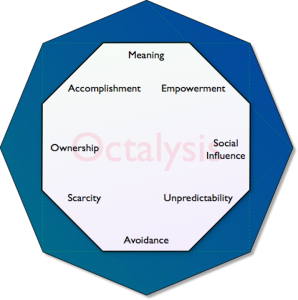GAMIFICATION OF ELECTIONS – PART 4
The last chapter introduced us to different ways to encourage player behaviour, by exploiting their desire for gratification. These techniques are short cycle loops, that repeat often and foreseeably, to reinforce the player’s desire to engage with the game mechanics. They do not, however, drive the player’s desire to play the game! Feedback loops (to be detailed in a later chapter) are not the reason why someone will pick up the game again and again.
In order to keep the users returning to the game, there must be some higher form of motivation. Something the player seeks – a great driver behind their actions. The exact nature of these drivers is hard to define. Essentially, they can be anything the players are willing to put personal or emotional value into. While their appearance differs from game to game, they all can be grouped together in several distinct categories. Yu-kai Chou describes these motivational drivers – the “Octalysis” – in his book “Actionable Gamification: Beyond Points, Badges, and Leaderboards”:
- Drive #1: Epic Meaning & Calling
When people are urged to become a part of something that is bigger than themselves. When they participate in some grand scheme or effort. This is the classic “Save the kingdom from evil” quest line. This narrative driven motivator is the reason, why people donate to Wikipedia, take part in sport rivalries or – in extreme cases – fight to the death for what they believe in.

- Drive #2: Development & Accomplishment
Growth and progress are evolutionary drivers inside our brain. They ensure that we strive towards accomplishing growth – emotional as well as physical. Laying out a clear and comprehensible path for growth to the player not only whets their appetite for what’s to come, but also encourages them spare the effort. This can come in the form of skill trees (more on them in a later chapter) or a simple overworld map view, that lays out the path to the castle, where the evil wizard resides. Levels, or boss fights give the game structure, and therefore the feeling of accomplishing milestones and achieving growth.
- Drive #3: Empowerment of Creativity & Feedback
People are creative by nature and even though not always able to, they want to release that creativity in some meaningful way. This driver taps into that creative potential that is hidden in each player and their desire to act on it. Creative does not necessarily imply artistic. Creativity can be applied in puzzle solutions or in strategy games. Experimenting and finding the right combinations of plants in Plants vs. Zombies to beat the level is as much a creative process as customizing your house and Sim in The Sims. Minecraft did an exceptional job at this, considering its only goal is to do/build/create whatever the player wants – thus becoming one of the most popular games of all time.
- Drive #4: Ownership & Possession
Again, one of our most basic traits is the concept of ownership. Our brain has a very special connection to the things we own. People put value into their possessions, even into things they don’t necessarily want or need. Players care for their items, for the empires and for their other achievements – fictional or not. By giving players a readout on their status, like status points, a rank or simply gold coins, games drive players to not only protect their status/rank/gold – in accordance to Core Drive #2 – but also to expand and increase said accomplishments.
The next chapter will discuss the last four Core Drives according to Yu-kai Chou.
Up next: Driving the point home
Further reading:
https://yukaichou.com/gamification-examples/octalysis-complete-gamification-framework
